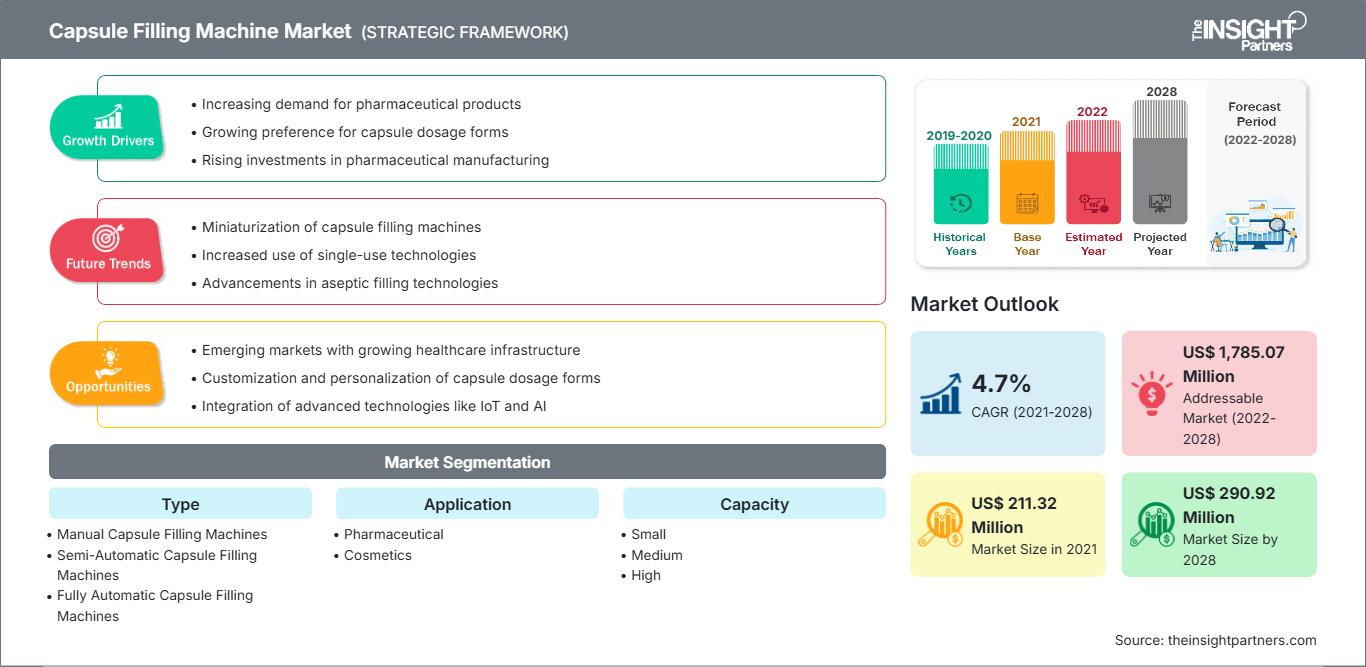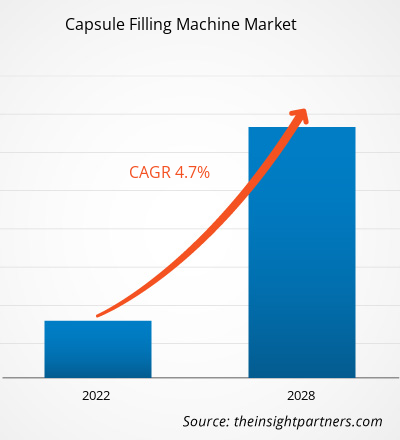[Rapporto di ricerca]Si prevede che il mercato delle macchine per il riempimento di capsule raggiungerà i 290,92 milioni di dollari entro il 2028, rispetto ai 211,32 milioni di dollari del 2021; si prevede una crescita a un CAGR del 4,7% tra il 2021 e il 2028.
Le macchine per il riempimento di capsule, note anche come macchine per l'incapsulamento, sono dispositivi meccanici ampiamente utilizzati in ambito farmaceutico e industriale. Queste macchine riempiono capsule vuote di gelatina morbida o dura di varie dimensioni con polveri, granuli, semisolidi o liquidi contenenti principi attivi farmaceutici o una combinazione di principi attivi farmaceutici ed eccipienti. Le macchine sono utilizzate in un'ampia gamma di settori, come quello chimico, farmaceutico, dei mangimi e alimentare e delle bevande. Per i vari tipi di macchine per il riempimento di capsule, ci sono circa 1.600 installazioni a livello globale.
La crescita del mercato delle macchine per il riempimento di capsule è attribuibile al progresso delle macchine per il riempimento di capsule e alla crescente prevalenza di malattie croniche. Tuttavia, gli elevati costi di produzione delle macchine per il riempimento di capsule ne ostacolano la crescita.
Personalizza questo rapporto in base alle tue esigenze
Potrai personalizzare gratuitamente qualsiasi rapporto, comprese parti di questo rapporto, o analisi a livello di paese, pacchetto dati Excel, oltre a usufruire di grandi offerte e sconti per start-up e università
Mercato delle macchine per il riempimento di capsule: Approfondimenti strategici

-
Ottieni le principali tendenze chiave del mercato di questo rapporto.Questo campione GRATUITO includerà l'analisi dei dati, che vanno dalle tendenze di mercato alle stime e alle previsioni.
Approfondimenti di mercato: la crescente prevalenza di malattie croniche stimola il mercato delle macchine per il riempimento di capsule
La crescente prevalenza di malattie croniche, come malattie cardiovascolari (CVD), cancro, diabete, ictus e malattie renali, ha aumentato la domanda di macchine per il riempimento di capsule per facilitare la produzione di capsule medicinali. Secondo l'OMS, le malattie cardiovascolari sono la principale causa di morte nel mondo, uccidendo 17,9 milioni di persone ogni anno. Inoltre, la crescente prevalenza del diabete ha aumentato la necessità di capsule medicinali, determinando un aumento della domanda di macchine per il riempimento di capsule. Secondo la nona edizione del Diabetes Atlas della International Diabetes Federation, circa 463 milioni di adulti (di età compresa tra 20 e 79 anni) soffrivano di diabete nel 2019, con una previsione di 700 milioni entro il 2045. Anche la crescente prevalenza del cancro sta aumentando la domanda di macchine per il riempimento di capsule. Secondo l'OMS, il cancro è stata la seconda causa di morte a livello mondiale, con 9,6 milioni di decessi nel 2018. L'aumento dei casi di malattie renali croniche a livello mondiale ha anche aumentato la necessità di farmaci giornalieri, il che si riflette sulla crescita del mercato. Il National Institute of Diabetes and Digestive and Kidney Diseases ha dichiarato in un rapporto che oltre 661.000 americani hanno sofferto di insufficienza renale nel 2018, di cui 468.000 necessitavano di dialisi e farmaci giornalieri. A causa della crescente frequenza di malattie croniche e infezioni, la domanda di prodotti farmaceutici sta registrando un rapido aumento, sottolineando l'importanza delle macchine per il riempimento di capsule.
Approfondimenti basati sulla tipologia
Il mercato delle macchine per il riempimento di capsule, per tipologia, è segmentato in macchine per il riempimento di capsule manuali, macchine per il riempimento di capsule semiautomatiche e macchine per il riempimento di capsule completamente automatiche. Il segmento delle macchine riempitrici di capsule completamente automatiche ha detenuto la quota di mercato maggiore nel 2021. Inoltre, si prevede che lo stesso segmento registrerà il CAGR più elevato del mercato durante il periodo di previsione.
Approfondimenti basati sulle applicazioni
Per applicazione, il mercato delle macchine riempitrici di capsule è segmentato in farmaceutico, cosmetico e altri. Nel 2021, il segmento farmaceutico ha detenuto la quota di mercato maggiore. Inoltre, si prevede che il segmento registrerà il CAGR più elevato tra il 2021 e il 2028.
Approfondimenti basati sulla capacità
Il mercato delle macchine riempitrici di capsule, in base alla capacità, è segmentato in piccole (fino a 50.000 capsule), medie (da 50.000 capsule a 100.000 capsule all'ora) e alte (oltre 100.000 capsule all'ora). Nel 2021, il segmento delle piccole capsule (fino a 50.000 capsule) ha detenuto la quota di mercato maggiore. Inoltre, si prevede che il segmento registrerà il CAGR più elevato, pari al 5,0%, tra il 2021 e il 2028.
Il lancio e l'approvazione di nuovi prodotti sono strategie comunemente adottate dalle aziende per espandere la propria presenza globale e il proprio portafoglio prodotti. Inoltre, gli operatori del mercato delle macchine per il riempimento di capsule si concentrano sulla strategia di partnership per ampliare la propria clientela, il che, a sua volta, consente loro di mantenere il proprio marchio in tutto il mondo.
Mercato delle macchine per il riempimento di capsuleLe tendenze e i fattori regionali che hanno influenzato il mercato delle macchine per il riempimento di capsule durante il periodo di previsione sono stati ampiamente spiegati dagli analisti di The Insight Partners. Questa sezione illustra anche i segmenti e la geografia del mercato delle macchine per il riempimento di capsule in Nord America, Europa, Asia-Pacifico, Medio Oriente e Africa, America Meridionale e Centrale.
Ambito del rapporto di mercato delle macchine per il riempimento di capsule
| Attributo del rapporto | Dettagli |
|---|---|
| Dimensioni del mercato in 2021 | US$ 211.32 Million |
| Dimensioni del mercato per 2028 | US$ 290.92 Million |
| CAGR globale (2021 - 2028) | 4.7% |
| Dati storici | 2019-2020 |
| Periodo di previsione | 2022-2028 |
| Segmenti coperti |
By Tipo
|
| Regioni e paesi coperti |
Nord America
|
| Leader di mercato e profili aziendali chiave |
|
Densità degli operatori del mercato delle macchine per il riempimento di capsule: comprendere il suo impatto sulle dinamiche aziendali
Il mercato delle macchine per il riempimento di capsule è in rapida crescita, trainato dalla crescente domanda degli utenti finali, dovuta a fattori quali l'evoluzione delle preferenze dei consumatori, i progressi tecnologici e una maggiore consapevolezza dei benefici del prodotto. Con l'aumento della domanda, le aziende stanno ampliando la propria offerta, innovando per soddisfare le esigenze dei consumatori e sfruttando le tendenze emergenti, alimentando ulteriormente la crescita del mercato.

- Ottieni il Mercato delle macchine per il riempimento di capsule Panoramica dei principali attori chiave
Profili aziendali
- ACG
- Capsugel, Inc (una sussidiaria di Lonza Group AG)
- Schaefer Technologies
- Syntegon Technology GmbH
- Torpac Inc.
- Zhejiang Fuchang Machinery Co.
- Ltd; Beijing Hanlin Hangyu Technology Development Inc.
- M2G Srl;
- IMA Industria Macchine Automatiche SpA
- Analisi storica (2 anni), anno base, previsione (7 anni) con CAGR
- Analisi PEST e SWOT
- Valore/volume delle dimensioni del mercato - Globale, Regionale, Nazionale
- Industria e panorama competitivo
- Set di dati Excel
Report recenti
Rapporti correlati
Testimonianze
Motivo dell'acquisto
- Processo decisionale informato
- Comprensione delle dinamiche di mercato
- Analisi competitiva
- Analisi dei clienti
- Previsioni di mercato
- Mitigazione del rischio
- Pianificazione strategica
- Giustificazione degli investimenti
- Identificazione dei mercati emergenti
- Miglioramento delle strategie di marketing
- Aumento dell'efficienza operativa
- Allineamento alle tendenze normative






















 Ottieni un campione gratuito per - Mercato delle macchine per il riempimento di capsule
Ottieni un campione gratuito per - Mercato delle macchine per il riempimento di capsule